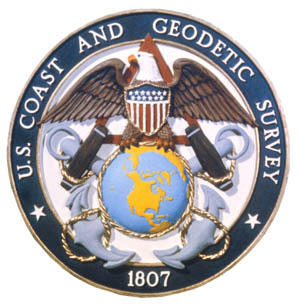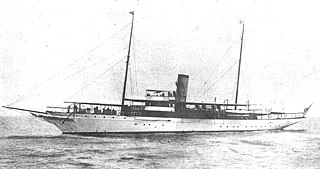
USS Flamingo (AM-32) was a Lapwing-class minesweeper built for the United States Navy near the end of World War I. After service overseas clearing mines after the Armistice, the ship was laid up until 1922 when she was transferred to the United States Department of Commerce for use by the United States Coast and Geodetic Survey. Renamed USC&GS Guide, the ship operated as a survey vessel along the West Coast of the United States for 17 years, making significant contributions to navigation, hydrographic surveying, and oceanography. In June 1941, Guide was transferred back to the Navy, converted into a salvage ship, and renamed USS Viking (ARS-1). As Viking, she worked primarily from bases in California until 1953, when she was sold for scrapping.

William Pope McArthur was an American naval officer and hydrologist who was involved in the first surveys of the Pacific Coast for the United States Coast Survey.

USS Oceanographer (AGS-3) was a survey ship of the United States Navy during World War II that produced charts chiefly of passages in the Solomon Islands area of the Pacific Ocean. Upon transfer to the Navy, she had initially briefly been named and classed as gunboat USS Natchez (PG-85). Before her World War II Navy service, she had been USC&GS Oceanographer (OSS-26), a survey ship with the United States Coast and Geodetic Survey from 1930.

The United States Coast and Geodetic Survey, known from 1807 to 1836 as the Survey of the Coast and from 1836 until 1878 as the United States Coast Survey, was the first scientific agency of the United States Government. It existed from 1807 to 1970, and throughout its history was responsible for mapping and charting the coast of the United States, and later the coasts of U.S. territories. In 1871, it gained the additional responsibility of surveying the interior of the United States and geodesy became a more important part of its work, leading to it being renamed the U.S. Coast and Geodetic Survey in 1878.

The fifth USS Ranger (SP-237) was United States Navy patrol vessel in commission from 1917 to 1919.

USS Lydonia (SP-700) was United States Navy patrol vessel in commission from 1917 to 1919 that saw service during World War I. Prior to her U.S. Navy service, she had been William A. Lydon's private yacht, Lydonia II, from 1912 to 1917. She spent most of the war based at Gibraltar, escorting and protecting Allied ships in the Mediterranean and along the Atlantic Ocean coast of Europe. After her U.S. Navy service ended, she served from 1919 to 1947 in the United States Coast and Geodetic Survey as the coastal survey ship USCGS Lydonia (CS-302).

USC&GS Pioneer was a survey ship that served in the United States Coast and Geodetic Survey from 1922 to 1941. She was the first ship of the Coast and Geodetic Survey to bear the name.

USS Surveyor was an armed steamer that served in the United States Navy from 1917 to 1919. Prior to her U.S. Navy service, she operated as the survey ship USC&GS Surveyor for the United States Coast and Geodetic Survey in 1917, and she returned to that role after her U.S. Navy decommissioning, remaining in Coast and Geodetic Survey service until 1956.

USS Elsie III (SP-708) was a United States Navy patrol vessel in commission from 1917 to 1919 that saw service during World War I. After the completion of her U.S. Navy career, she was in commission in the United States Coast and Geodetic Survey as the survey launch USC&GS Elsie III from 1919 to 1944.

USC&GS Ranger was a steamer that served in the United States Coast and Geodetic Survey from 1919 to 1930 or 1931.

Gilbert T. Rude (1881–1962) was an officer in the United States Coast and Geodetic Survey—one of the ancestor organizations of the United States National Oceanic and Atmospheric Administration (NOAA) -- and the United States Navy. He served as Chief of the Division of Coastal Surveys in the Coast and Geodetic Survey. A NOAA ship was named for him.

USC&GS Isis was a survey ship that served in the United States Coast and Geodetic Survey from 1915 to 1917 and from 1919 to 1920.

The first USC&GS Hydrographer was a survey launch that served in the United States Coast and Geodetic Survey from 1901 to 1917 and from 1919 to 1928.

The first USC&GS Discoverer was a survey ship that served in the United States Coast and Geodetic Survey from 1922 to 1941.

The second USC&GS Guide was a survey ship that served in the United States Coast and Geodetic Survey from 1941 to 1942.

USC&GS Mikawe was a United States Coast and Geodetic Survey launch in commission from 1920 to 1939.

USC&GS A. D. Bache, the second steamer of the United States Coast and Geodetic Survey, was named for Alexander Dallas Bache, a former superintendent of the Survey. She was launched in August 1871 at Wilmington, Delaware, and was in commission from 1871 to 1900.

USS Onward (SP-311), a former yacht named Galatea and then Ungava was a patrol yacht acquired by the U.S. Navy during World War I. She was transferred to the United States Coast and Geodetic Survey where she served briefly until return to the Navy for a brief time before her disposal by sale. She was renamed Thelma Phoebe.

USS Helianthus (SP-585) was a patrol vessel in commission in the United States Navy from 1917 to 1919, seeing service in World War I. After her U.S. Navy service, she was in commission in the United States Coast and Geodetic Survey as the survey launch USC&GS Helianthus from 1919 to 1939. She was named after the Helianthus, the genus to which the sunflower belongs.

USS Scandinavia (SP-3363) was a patrol vessel in commission in the United States Navy from 1918 to 1919, seeing service in World War I. After her U.S. Navy service, she was in commission in the United States Coast and Geodetic Survey as the survey launch USC&GS Scandinavia from 1919.




















